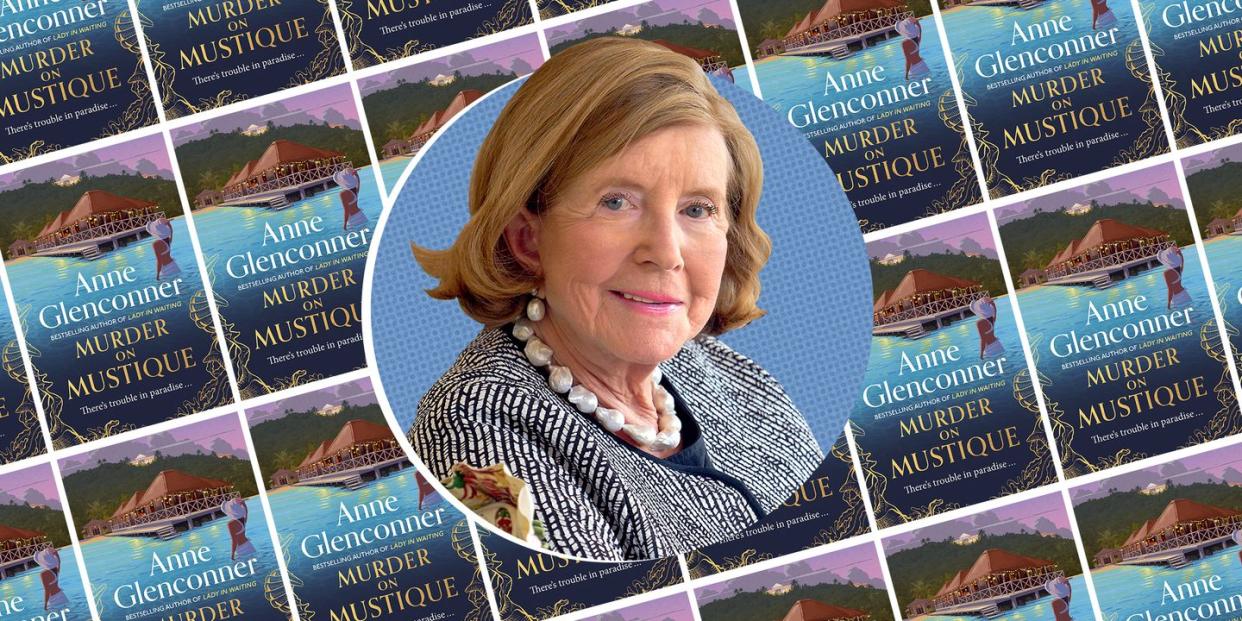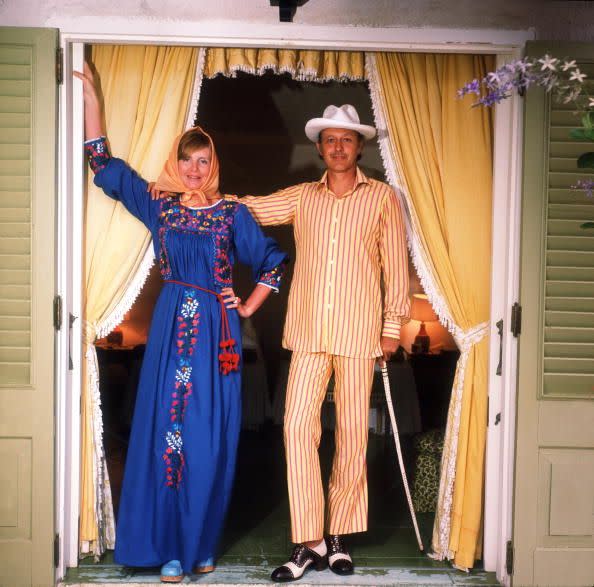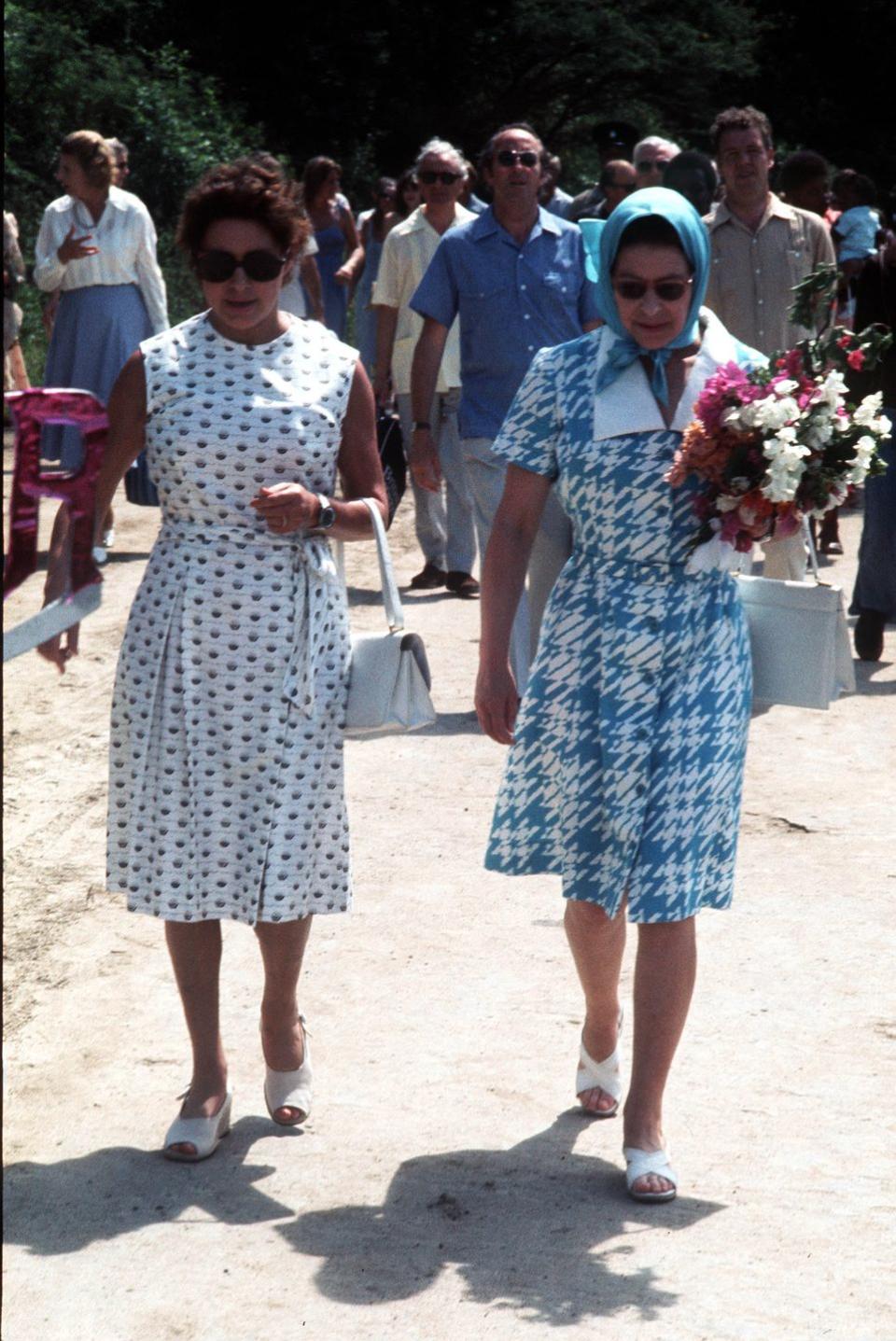Lady Glenconner Thinks Princess Margaret "Might Rather Like" Her New Book Murder on Mustique

Lady Anne Glenconner was perhaps always destined to be a novelist. After all, her parents named her after an H.G. Wells character. Still, she came to writing late in life. “I've always told stories,” Glenconner, who is 88, tells me over the phone, “but I had no idea I would become a writer.”
Her publishing career began in earnest just a few years ago when a friend prompted her to write a memoir, a book of stories about her life and close friendship with Princess Margaret, which would become Lady in Waiting: My Extraordinary Life in the Shadow of the Crown. “He said, "Have you ever thought of writing a book?" And I thought, "Well, no. I'm actually rather old now to start." But he said, ‘Try.’ And it all came pouring out. In fact, people said, "Do you get writer's block?" And I said, ‘No, no. I got writer's diarrhea!’” Glenconner says, laughing.
Putting her memories down on paper, she realized just how exceptional her life had been. “While I was writing it, I realized I had led a very interesting life. The sort of life I led doesn't really exist anymore,” she says.
Glenconner’s aristocratic upbringing—her father was the 5th Earl of Leicester, and an equerry to King George VI—and intimate connection to the British royal family are likely what inspire many to pick up her memoir; she spent her childhood playing with Princess Margaret, and remained a friend and confidante to the Queen’s sister until the royal passed away in 2002. The book’s title is, of course, a reference to Glenconner’s official position attending the princess. But the pages of the book aren’t exclusively filled with glamorous travel, sparkling jewelry, and intimate conversations in the corridors of Kensington Palace; at times, her words paint a shockingly honest picture of some of the most difficult experiences a person can endure, from losing a child to AIDS to watching another battle a heroin addiction.
“My book covers a lot of things, my life. I mean, I've lost children. Sad things have happened to me and marvelous, amazing things, like being a train bearer at Queen Elizabeth’s coronation. And it seems to appeal to all sorts of people. They might write to me and say, ‘I've got a very difficult husband. Interesting how you dealt with him.’ And all that sort of thing. Or, ‘I've lost a child, and the way you wrote about it, you gave me strength,’” she says.
In Lady in Waiting, she described her life this way: “From a generation where we were taught not to overthink, not to look back or question, only now do I see how extraordinary the nine decades of my life have really been, full of extreme contrasts. I have found myself in a great many odd circumstances, both hilarious and awful, many of which seem, even to me, unbelievable.” But there are a few memories she saved just for herself. “In people's lives, there are always things that are private. There was quite a lot I didn't put in, that I didn't want to put in there,” she says.
After the success of Lady in Waiting, Glenconner wanted to keep writing, but she was ready to try something different. Her second book, Murder on Mustique, out in the U.S. today, is a mystery novel, set on the Caribbean island of Mustique, which Glenconner’s late husband Colin Tennant, 3rd Baron Glenconner, owned at one point, and helped to shape into an exclusive vacation destination. It’s a classic whodunnit, with multiple murders and intrepid detectives, a storm looming, and an extravagant party to plan—the epitome of a page-turning beach read.
“Having written Lady in Waiting, [my publisher] wanted me to write another book, and I've always loved Agatha Christie, always loved all her books. And I thought, Well, I might try and write one about Mustique, the island I knew very well. And so, I wrote it around the sort of people I knew there.”

Unlike Lady in Waiting, Murder on Mustique is a fictionalized story, but one that includes more than a few familiar faces. “The thing is, I have to be so careful nowadays with the lawyers, about writing about real people. And so, I made all the characters on Mustique fictitious,” she explains. But the similarities between some of the story’s island inhabitants, and those who frequent the real-life Mustique are pretty clear.
“Obviously, Lady Veronica Blake is me. Lady V, for short. She's very like me, but she’s also based somewhat on Agatha Christie's Miss Marple. I would've liked to have been a lady detective, so that's why Lady V is me, and she is a detective,” Glenconner says. To further the connection, Lady V is also named after “a particularly stalwart heroine in a novel by H.G. Wells.”
Similarly, a version of Glenconner’s late husband appears in the book. “I gave him a glamorous name, because he never liked being called Colin. So I thought Jasper. He's sadly dead, my husband. But if he was alive, I'm sure he'd be pleased that I called him Jasper. And I put him on Saint Lucia. I didn't have him on the island, because he would have taken the book over,” she says.
Lily, another key character, was inspired by one of Glenconner’s nieces, and there’s a musician on the island with a passing resemblance to Mick Jagger. “They're all based, bits, on people I know. I find that easier to write if you've got somebody really in mind,” she says. Princess Margaret also gets a few mentions; Lady V, like Lady Glenconner, is mourning her late friend.

“I didn't want her [to play a role] in the book, so I set it after Princess Margaret had died. But I do bring her in a bit. The publishers always want to bring her in a lot. I said I'd bring her in a little bit, but the book wasn't about her,” Glenconner says. “I think she might rather like the book. She was a great reader. She loved books. When I used to go out with her to Mustique, she always had a suitcase full of books.”
The island is also a character in its own right in Glenconner’s book. “I take [the reader] around Mustique. I show them the island, the feel of it, the small of it and all that, and the sea,” she says.
“There's wonderful beaches, I mean, beautiful, and swimming. One side of the island is the Atlantic, and one side is the Caribbean. So the Atlantic side, you get fairly rough waves, and it's just like swimming in champagne. The waves come over the coral reefs and make it bubbly and lovely. And then the Caribbean side is very calm.”
Colin famously gave Princess Margaret a plot of land and a home on Mustique as a wedding present following her 1960 marriage to Antony Armstrong-Jones, and in return, she brought a certain cachet to the island, which it still retains today.
“Princess Margaret never had a house in the country, which I always thought rather sad. She just had the one in London. That's why she loved Mustique so much, because it was the first house that she actually owned,” Glenconner says. “She never owned anything before. We shopped for all the furniture, very simple furniture, and then we used to collect shells on the beach. We used to make tables. We'd collect those tiny, little, pink shells, and we did some beautiful tabletops. She was very artistic, Princess Margaret. We had great fun, doing all that, looking back on it all.”

Today, the island remains a favorite vacation destination for royals and rockstars alike.
“It's extraordinary. What's interesting is, there's no golf course, no night club. There's one shop, no big hotel. There's nothing there, and yet people just want to live there. It's very safe for children. Children love it. Wonderful beaches, sea, and there are water sports and all that sort of thing,” Glenconner says. But the real key to the island’s popularity among the elite and world famous is its privacy.
“[Mustique] is still known for its privacy today. Colin was very clever in insisting that nobody could be on the island unless they had a house or a room at the hotel. This meant that the press couldn’t get on because, even if they arrived at the jetty, they were turned away,” Gleconner writes in Lady in Waiting. “The Cotton House has only 12 rooms and the houses rent for huge sums of money, so the exclusivity and privacy has always been maintained.”
The Duke and Duchess of Cambridge are among those known to visit nowadays (in non-pandemic times, that is). “The Cambridges come with their children, and I was talking to them. I was on the airplane going out with them about two year ago, and I said ... Colin was dead by that time, I said, 'Colin would be so pleased that you love coming to Mustique,'” Glenconner remembers. “And they said, ‘Well, it's wonderful. The children absolutely adore it. Nobody bothers us. Nobody takes any notice of us.”
“And that's true, because you see, we've always had grand people there, Mick Jagger and David Bowie and all these sort of people. And nobody takes any notice. I think that's what people appreciate.”

Murder on Mustique may be Glenconner’s first novel, but she’s no stranger to having her life serve as inspiration for entertainment. In seasons three and four of The Crown, she was portrayed by actress Nancy Carroll. But Glenconner gives little credit to the show’s research department.
“I think they should say that it is pure fiction. Helena Bonham Carter, who played Princess Margaret in the last one, came and saw me. She said, ‘Can I come and see you and talk about Princess Margaret?’ I said, ‘I'd love it.’ And she came. She spent about three hours, asking a lot of questions. I told her how Princess Margaret smoked and walked, how I'd never see her run, all that sort of thing. But of course, after, she said, ‘Do you like my portrayal?’ And I said, ‘Well, I mean, the bit where I was in it, when she first met Roddy, is completely untrue.’”
She continues, “The trouble is that people believe it, don't they? People think it's true, and there's nothing much you can do about it. A lot of quite important people have said, really, The Crown should have a disclaimer at the beginning saying that this is fiction. But anyway, there we are. Nothing we can do about it.”

That said, she did appreciate the way Bonham Carter played Princess Margaret, and instead takes issue with the script and the storylines.
“I thought Helena was really good as Princess Margaret. She spoke like her, she looked like her. She was, I thought really quite good, but she's made to do all sorts of ridiculous things. Like when Princess Margaret was in America, there was one evening when they were making up rather crude limericks,” Glenconner says, referencing an episode in season three, when Princess visits the White House. “She'd never do that. If you know a person, you know at once that they wouldn't do that.”
While Glenconner’s book only hits shelves today in the States, she’s already moved on to her next project, a novelization of her experience during WWII, which is set to come out later this year.
“It's going to be about Holkham, my family home, which is a very huge house, a stately home. And I'm writing about being there in the war, with my grandfather. We had prisoner-of-war camps in the park,” she explains.
“A lot of it is true, real, and a little bit is made up by me. One or two spies appear and that sort of thing. My governess turns out to be a spy. I never liked her very much. I always had it in for her. But it's not finished yet.”
“I think that will be my last book, and then I'm going to hang up my pen,” she says. “By that time, I'll be nearly 90, and I think I've probably done enough.”
You Might Also Like


